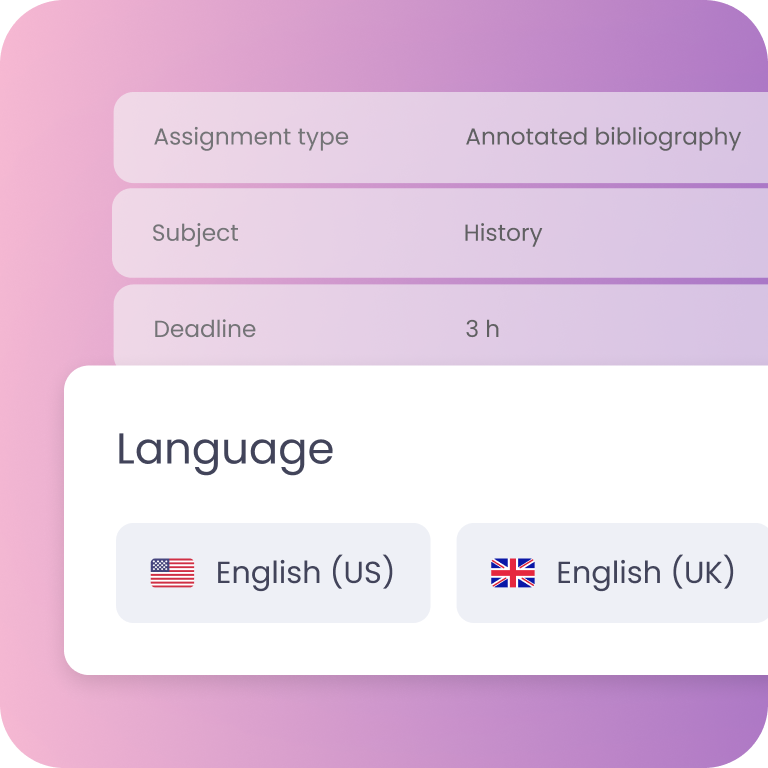Connect with annotated bibliography writers
Access verified pros, look through profiles, and pick the person who fits your assignment.
Our customers are talking
We ask for honest feedback once the job is done. Check our latest customer reviews.
Great communication and work again.
great work! and done way before needed!
Great communication and work again.
Great writing skills, excellent work.
Excellent writing. Followed instructions and paper was exactly what was needed.
Exceptional work and delivered in a timely manner with great references!
Great job in completing the order given very specific instructions and writing format.
The paper was done ahead of time and was great overall. The writer followed all of my directions and requests. Thank you.
Great work
Did a wonderful job! He finished in one day when I originally asked for a 2 day deadline. Great grammar and communication skills.
I had a research paper redo that was stressing me out and I only had one day to get it done and send it back to the professor this service help me out so much I will use it again. Very happy with how the paper come out
Excellent work exactly what I was looking for thank you so much
This was a great experience. The writer that I hired was extremely quick, fast, and helpful.
Very fast and thorough work! She met every point and requirement and did it before the time limit i set was up!
Had an excellent experience working with this essay writer. The writing was clear, well-structured, and thoroughly researched. They paid close attention to the requirements, delivered everything on time, and even exceeded my expectations with thoughtful analysis and strong arguments. I highly recommend Edwin to anyone looking for reliable and professional academic writing support.
Takes his time and keeps you updated throughout the process! Great work overall
It was amazing I really enjoyed this app. I would definitely be using again
Solid tool without all the extra stuff just your basic plag checker that works good and gives you great results every time.
can’t lie, i was nervous but the expert nailed it. smooth and easy process
Every assignment feels like it’s been reviewed twice before delivery. I trust them with my work and info every single time tbh.
i felt safe using this platform, no leaks or weird stuff. writing was ok too, kept privacy safe !
My expert was friendly and easy to work with! Missed one reference, but still way better than doing it alone haha
work looked clean and ai-free. definitely trust this service again...
The expert followed every tiny detail I listed and somehow still finished two days early. formatting, grammar and even sources looked perfect
The expert handled the assignmnt I’d been stuck on for days. Came out polished and totally natural, nothing robotic at all.
Why students choose our annotated bibliography writing service
Highly unique work
Affordable prices
Minimum 3-hour completion
Trusted experts
Round-the-clock support
Easy order process
Data security guaranteed
Personalization
Unlimited edits
Simple steps to buy annotated bibliography
Step 1. Fill out the form
Make sure to be specific and give us all the information we might need to complete your task. Clear instructions attract more proposals from our expert writers.

Step 2. Choose your writer
Get proposals and pick the writer you want. Place the funds to finalize your order. Stay in touch to track progress and share extra info if needed.

Step 3. Review & pay
Once your order is complete, you will get an email notification. Go over the draft to see if you need anything changed. As soon as you are happy, release the funds.

Annotated bibliography prices
Writing
from $10.80
Rewriting
from $7.56
Editing
from $5.40
Proofreading
from $3.24
Still deciding whether to order an annotated bibliography?
At EssayService, everything’s built to take the pressure off your studies. If you’re short on time or tired writing of revising, let an experienced writer handle your assignment. You’ll get polished, properly formatted work without the extra stress. Buy annotated bibliography paper today and stay on track with less effort.
Frequently asked questions
Is it safe to let someone write my annotated bibliography?
Absolutely! We prioritize the security of your information by utilizing advanced data-handling technologies and strict security protocols so you can use our services with peace of mind.
Do you have a money-back guarantee?
Ordering here comes with peace of mind. You can request changes from your annotated bibliography writer at no cost, and if it doesn’t meet your expectations, our Refund Policy has you covered.
What citation styles do you use?
Each expert handling your request to "write my annotated bibliography for me" knows every major citation style, including APA, MLA, and Chicago. Simply specify your preferred format when placing the order.
How fast does your annotated bibliography writing service work?
We take pride in our quick turnaround times. Our writers can often finish short tasks in just a few hours, helping you meet tight deadlines with ease.
How our annotated bibliography writing services approach pricing
We know price matters as much as quality. Many customers reach out saying, “I need someone to write my paper, but I’m not sure I can afford it.” That’s why our pricing system for annotated bibliography writing services is built around fairness, flexibility, and full transparency.
The final cost depends on three main factors: deadline, complexity, and length. Shorter deadlines are naturally priced higher since they require immediate attention, while longer ones allow you to save more. Simpler tasks like single-page bibliographies cost less, whereas complex research or analytical work may take more time and resources. We also offer discounts for bulk orders, so if you have several assignments coming up, planning ahead helps lower your overall cost.
We keep our process straightforward. The price you see before ordering is the final amount, no extra charges, no hidden fees. Payments are processed through secure methods, including Mastercard, Maestro, Visa, American Express, Discover, JCB, and Diners Club International.
Our goal is to make sure every customer gets access to professional, reliable help without financial strain. So when you ask, “can someone do my annotated bibliography for me?” you can be confident the price reflects the real effort behind quality work, not inflated rates or unnecessary add-ons.
Get help from a qualified annotated bibliography writer
Students often face small but time-consuming questions when preparing a bibliography. Should the first line be indented? Which format fits best, APA or MLA? How long should each annotation be, and how do you keep the tone consistent across sources? These details can turn what seems like a short task into hours of formatting and rewriting. That’s why many students turn to our custom annotated bibliography writing services for clear, reliable help.
When you ask us to "write an annotated bibliography for me," your task is handled by someone who knows exactly what each citation style requires. Every source is properly referenced, summarized, and explained in a way that connects directly to your research topic. Whether it’s part of a dissertation, term paper, or coursework, you’ll receive a structured and accurate bibliography that meets your academic standards.
Our writers don’t use templates or generic samples. Each order is prepared from scratch to reflect your materials, instructions, and goals. You can request any format: APA, MLA, Chicago, or Harvard, and be sure every entry follows the correct structure.
Write my annotated bibliography and ease my college life
Finding the right balance between classes, deadlines, and personal time isn’t easy. That’s why our custom annotated bibliography writing service exists, to take over the tasks that slow you down. When you hand your assignment to one of our writers, you get someone who knows how to research, format, and present information the right way.
Each professional annotated bibliography writer we work with has real experience handling academic materials. They know what a strong source looks like and how to explain why it matters in your research. Every annotation is written from scratch, based on your topic and requirements, with the right citation style and structure.
Here’s what you can expect when you order:
- Careful selection of relevant and credible sources.
- Proper formatting in APA, MLA, Chicago, or Harvard styles.
- Clear and structured annotations that connect to your research.
- Consistent tone and logical organization across entries.
- Grammar checks before delivery.
Our service is built to make things easier. The process is straightforward: you share your requirements, choosa a writer, and receive a polished, properly formatted bibliography that meets your requirements. You’ll get practical help from someone who takes your work seriously, meets your deadline, and delivers results you can depend on.
Annotated bibliography writing service covering all subjects
During studies, many students decide to buy an annotated bibliography when they realize how much the format varies between subjects. What’s expected in a philosophy paper is different from a chemistry report or a sociology project. Each field values a specific approach, level of analysis, and writing style, which makes adapting to every requirement challenging without guidance.
Humanities
In subjects like history, literature, and philosophy, annotations explain how a source fits into broader discussions. They look at the author’s argument, credibility, and how the work adds to ongoing debates. The goal is to show insight and connection, not just summarize.
Sciences
In fields such as biology, chemistry, and physics, the focus shifts to research methods, data accuracy, and results. The tone is straightforward and factual. Annotations explain how reliable the study is and what conclusions can be drawn.
Social Sciences
In areas like psychology, sociology, and economics, annotations connect theory to real-world use. They review the research approach and explain how the findings apply to practical settings.
Each discipline requires a unique balance between analysis and structure. When time is limited or instructions feel unclear, it’s easier to rely on expert help and simply say, "write an annotated bibliography for me."








